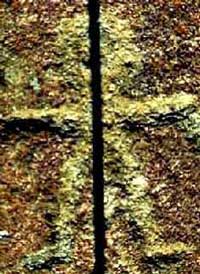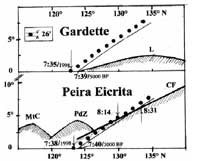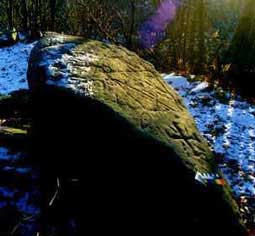
Léo DUBAL/ dubal@archaeometry.org
Bernard LACHAL/lachal@sc2a.unige.ch
Dario SEGLIE / cesmap@cesmap.it
The
invention of the 365 ¼ day calendar probably coincides
with
the origin of the scientific way of thinking:
it should indeed have significantly facilitated the discovery of
the "primal causality", i.e. the recognition of biological fatherhood.
The
invention of the solar calendar is relatively recent, dating only from
5'200 BP.
On December 21st 1969 Michael J. O’Kelly first interpreted a
trace,
in the corridor
of the megalithic monument of Newgrange,
of the search of a "zero of time",
in order to count the number of the
days of the solar year.
A
cultural activity of this kind surpassed the insular context,
quite
fortuitous, of this discovery.
According to our observations during the 1998 winter solstice
we assume
that two elevated sites of rupestrian art
decorated with kinds of sight-line or "alidad" -
to be further evidence
of this quest.
1)
The site called « La Gardette », is an erosion
resistant outcropping of gneiss
located on an hilltop at 835m,
in Hte Cèzarenque (near Aujac, in the Cevennes,
France:
N 44°21'40", E 4°01'34"). Its tilt of 25° faces
S-E, i.e.; 135°N,
and its engraved surface (4m x 4m) contains some thirty male
anthropomorphs.
At dawn of the winter solstice, the lighting of the engravings from
below
creates the illusion of inversion of relief (see Fig. 1),
and the
projected shadow of a plumb-line
confirms the deliberate orientation of the engraving's axis.


2) The site called
« La Peira Eicrita di San Germano Chisone »,
is a
gneiss monolith
with a nearly flat engraved area of 130 x 75 cm,
located on a salient of La Comba Farina in the Cotiennes Alps
(N
44° 53' 20" / E 7°14' 08").
The petroglyphs form a
monumental composition:
3 solar symbols (circular with a central dot),
connected to an eye-like
sign are recognisable,
converging on a reticule, several little cups,
on the side, an worshipper, and,
particularly striking (but probably of
later incision),
a swastika oriented along the cardinal points.
One of the solar symbols is oriented toward 135°N (see Fig.3).
Seen from La Peira Eicrita, the solar orb during its rise follows
the crest of La Comba Fossate whose summit (650m) overlooks the horizon
by 12°.
In the background on the left, see Fig. 2,
one can distinguish the "Sugar loaf" (721m) and the Mt Craviate (787m).

Seen
from La Peira Eicrita, the solar orb during its rise
follows the crest
of La Comba Fossate whose summit (650m)
overlooks the horizon by 12°.
In the background on the left,
see Fig. 2,
one can distinguish the "Sugar loaf" (721m) and the Mt
Craviate (787m).
The sun cannot be seen on the horizon-line at 8:09 local time (7:40
solar time),
but must first rise by 4°30' over the horizon to
reach
at 8:45 local time the crest of La Comba Fossata.
3000 years ago it had
even to rise by 6.5° over the horizon to be seen.
We
conclude that
the orientation of the engravings
at La Gardette and at La Peira
Eicrita
reveal within neolithic humanity a sense of observation
which merits the term scientific.
On the other
hand, the siting of those astronomical observatories
is also marked by a magical way of thinking:
the presentation suggests
that the "solstitial reversal"
takes place at those very sites:
the mountain repelling the sun.